Organisational Change Management Report: Complexities and Strategies
VerifiedAdded on 2020/06/06
|14
|3999
|67
Report
AI Summary
This report delves into the multifaceted realm of organizational change management, exploring the application of complexities theory by managers in strategic change implementation. It examines the ways in which businesses, both small and large, are adapting to globalization by expanding operations and utilizing new tools and techniques. The report analyzes the significance of strategic change management in restructuring business plans to achieve desired objectives. It also addresses the critical aspect of change resistance, identifying its causes, such as the belief that change is unnecessary, perceived risks, and lack of communication, and its impact on planned organizational change. The report highlights the importance of communication skills, patience, and leadership skills in change agents, emphasizing their role in influencing and guiding employees through the change process. Finally, it discusses the role of employees in achieving effective organizational change, underscoring the need for adaptable strategies and the importance of recognizing and addressing resistance to ensure successful outcomes.
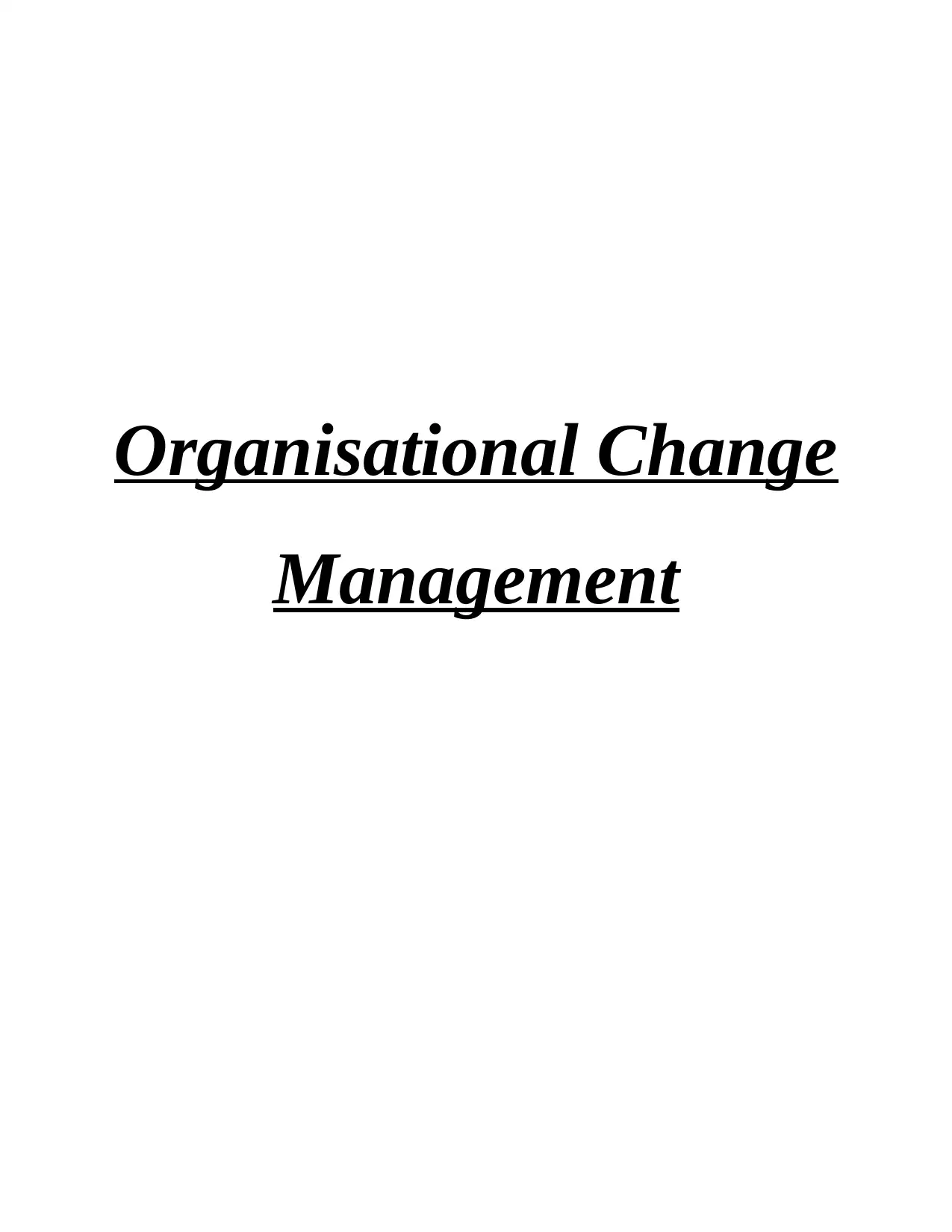
Organisational Change
Management
Management
Paraphrase This Document
Need a fresh take? Get an instant paraphrase of this document with our AI Paraphraser
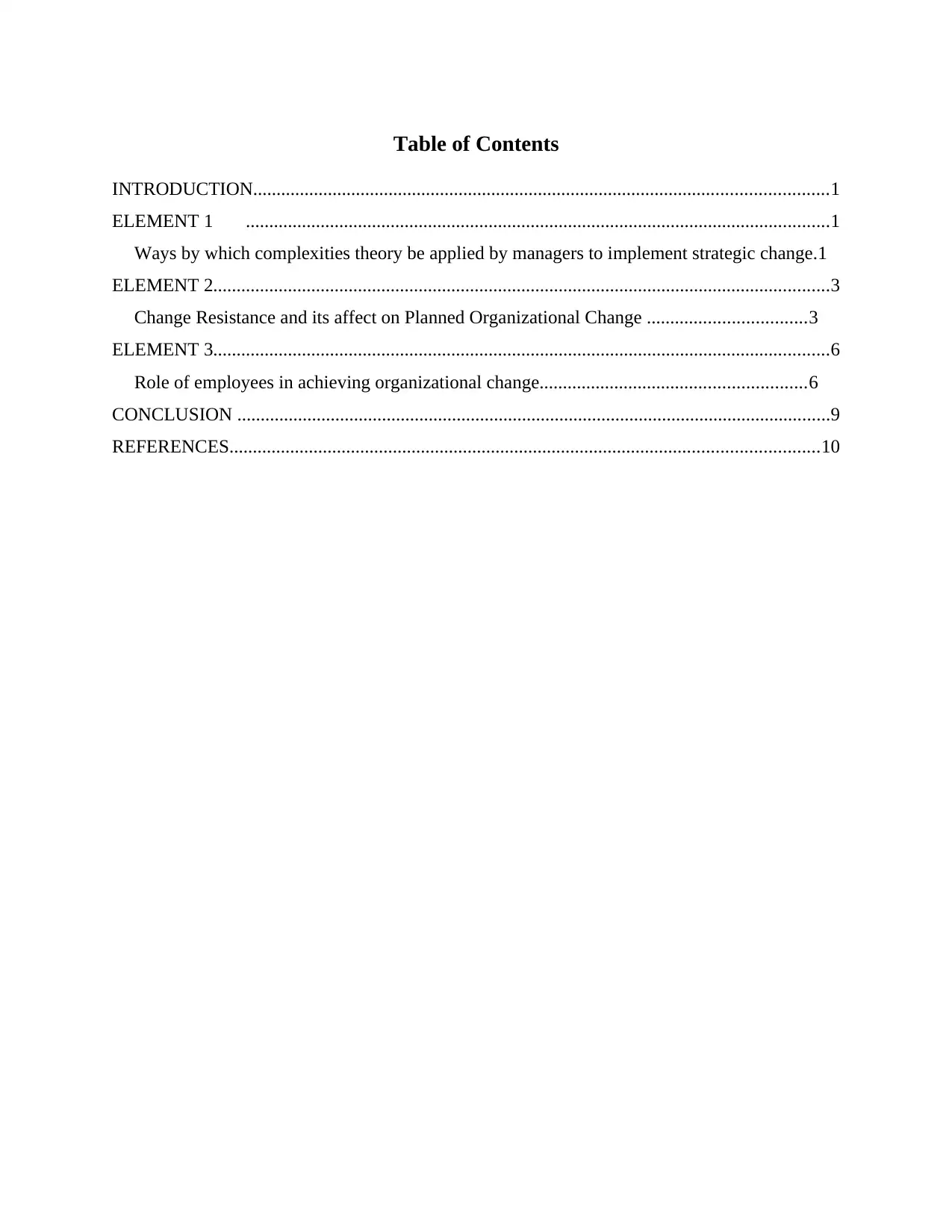
Table of Contents
INTRODUCTION...........................................................................................................................1
ELEMENT 1 .............................................................................................................................1
Ways by which complexities theory be applied by managers to implement strategic change.1
ELEMENT 2....................................................................................................................................3
Change Resistance and its affect on Planned Organizational Change ..................................3
ELEMENT 3....................................................................................................................................6
Role of employees in achieving organizational change.........................................................6
CONCLUSION ...............................................................................................................................9
REFERENCES..............................................................................................................................10
INTRODUCTION...........................................................................................................................1
ELEMENT 1 .............................................................................................................................1
Ways by which complexities theory be applied by managers to implement strategic change.1
ELEMENT 2....................................................................................................................................3
Change Resistance and its affect on Planned Organizational Change ..................................3
ELEMENT 3....................................................................................................................................6
Role of employees in achieving organizational change.........................................................6
CONCLUSION ...............................................................................................................................9
REFERENCES..............................................................................................................................10

⊘ This is a preview!⊘
Do you want full access?
Subscribe today to unlock all pages.

Trusted by 1+ million students worldwide
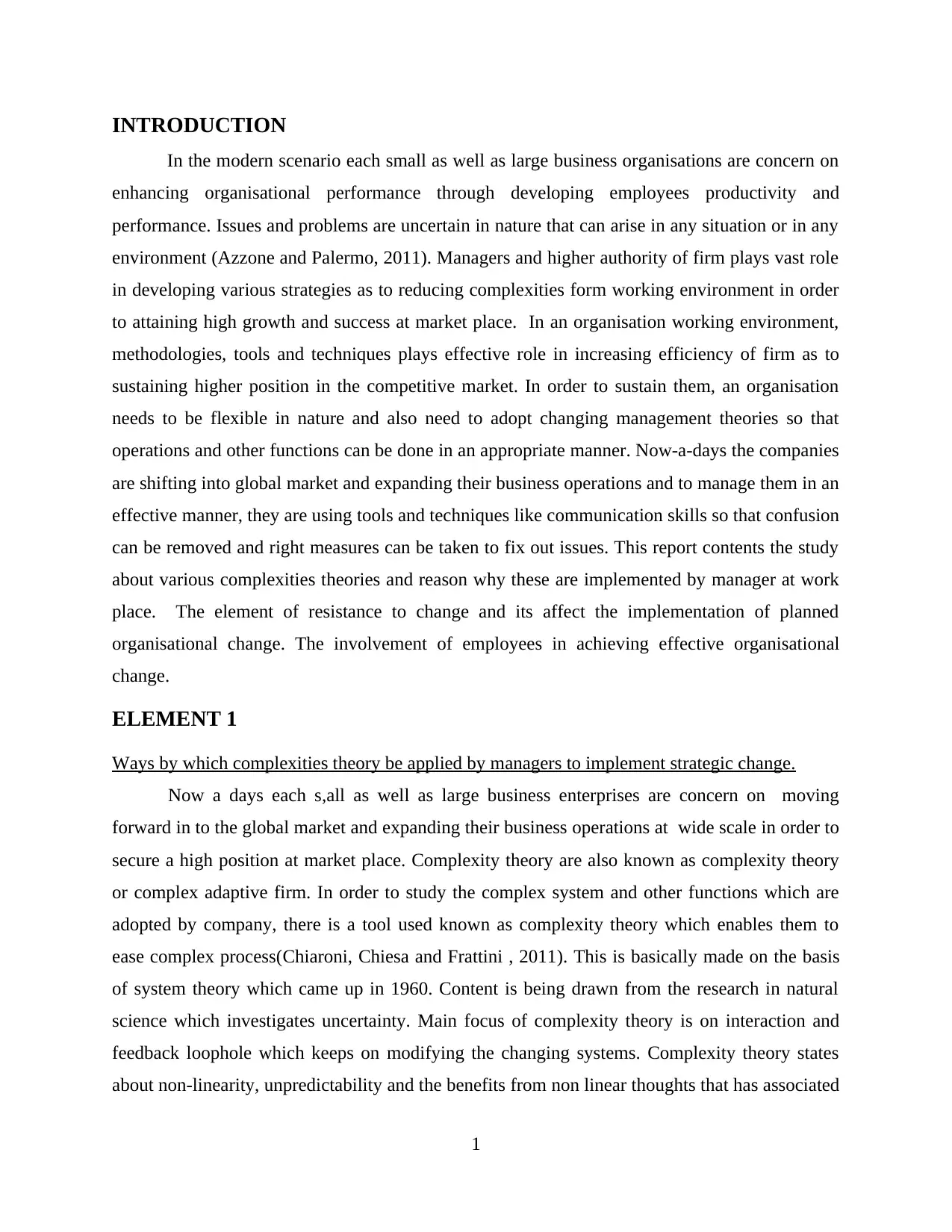
INTRODUCTION
In the modern scenario each small as well as large business organisations are concern on
enhancing organisational performance through developing employees productivity and
performance. Issues and problems are uncertain in nature that can arise in any situation or in any
environment (Azzone and Palermo, 2011). Managers and higher authority of firm plays vast role
in developing various strategies as to reducing complexities form working environment in order
to attaining high growth and success at market place. In an organisation working environment,
methodologies, tools and techniques plays effective role in increasing efficiency of firm as to
sustaining higher position in the competitive market. In order to sustain them, an organisation
needs to be flexible in nature and also need to adopt changing management theories so that
operations and other functions can be done in an appropriate manner. Now-a-days the companies
are shifting into global market and expanding their business operations and to manage them in an
effective manner, they are using tools and techniques like communication skills so that confusion
can be removed and right measures can be taken to fix out issues. This report contents the study
about various complexities theories and reason why these are implemented by manager at work
place. The element of resistance to change and its affect the implementation of planned
organisational change. The involvement of employees in achieving effective organisational
change.
ELEMENT 1
Ways by which complexities theory be applied by managers to implement strategic change.
Now a days each s,all as well as large business enterprises are concern on moving
forward in to the global market and expanding their business operations at wide scale in order to
secure a high position at market place. Complexity theory are also known as complexity theory
or complex adaptive firm. In order to study the complex system and other functions which are
adopted by company, there is a tool used known as complexity theory which enables them to
ease complex process(Chiaroni, Chiesa and Frattini , 2011). This is basically made on the basis
of system theory which came up in 1960. Content is being drawn from the research in natural
science which investigates uncertainty. Main focus of complexity theory is on interaction and
feedback loophole which keeps on modifying the changing systems. Complexity theory states
about non-linearity, unpredictability and the benefits from non linear thoughts that has associated
1
In the modern scenario each small as well as large business organisations are concern on
enhancing organisational performance through developing employees productivity and
performance. Issues and problems are uncertain in nature that can arise in any situation or in any
environment (Azzone and Palermo, 2011). Managers and higher authority of firm plays vast role
in developing various strategies as to reducing complexities form working environment in order
to attaining high growth and success at market place. In an organisation working environment,
methodologies, tools and techniques plays effective role in increasing efficiency of firm as to
sustaining higher position in the competitive market. In order to sustain them, an organisation
needs to be flexible in nature and also need to adopt changing management theories so that
operations and other functions can be done in an appropriate manner. Now-a-days the companies
are shifting into global market and expanding their business operations and to manage them in an
effective manner, they are using tools and techniques like communication skills so that confusion
can be removed and right measures can be taken to fix out issues. This report contents the study
about various complexities theories and reason why these are implemented by manager at work
place. The element of resistance to change and its affect the implementation of planned
organisational change. The involvement of employees in achieving effective organisational
change.
ELEMENT 1
Ways by which complexities theory be applied by managers to implement strategic change.
Now a days each s,all as well as large business enterprises are concern on moving
forward in to the global market and expanding their business operations at wide scale in order to
secure a high position at market place. Complexity theory are also known as complexity theory
or complex adaptive firm. In order to study the complex system and other functions which are
adopted by company, there is a tool used known as complexity theory which enables them to
ease complex process(Chiaroni, Chiesa and Frattini , 2011). This is basically made on the basis
of system theory which came up in 1960. Content is being drawn from the research in natural
science which investigates uncertainty. Main focus of complexity theory is on interaction and
feedback loophole which keeps on modifying the changing systems. Complexity theory states
about non-linearity, unpredictability and the benefits from non linear thoughts that has associated
1
Paraphrase This Document
Need a fresh take? Get an instant paraphrase of this document with our AI Paraphraser
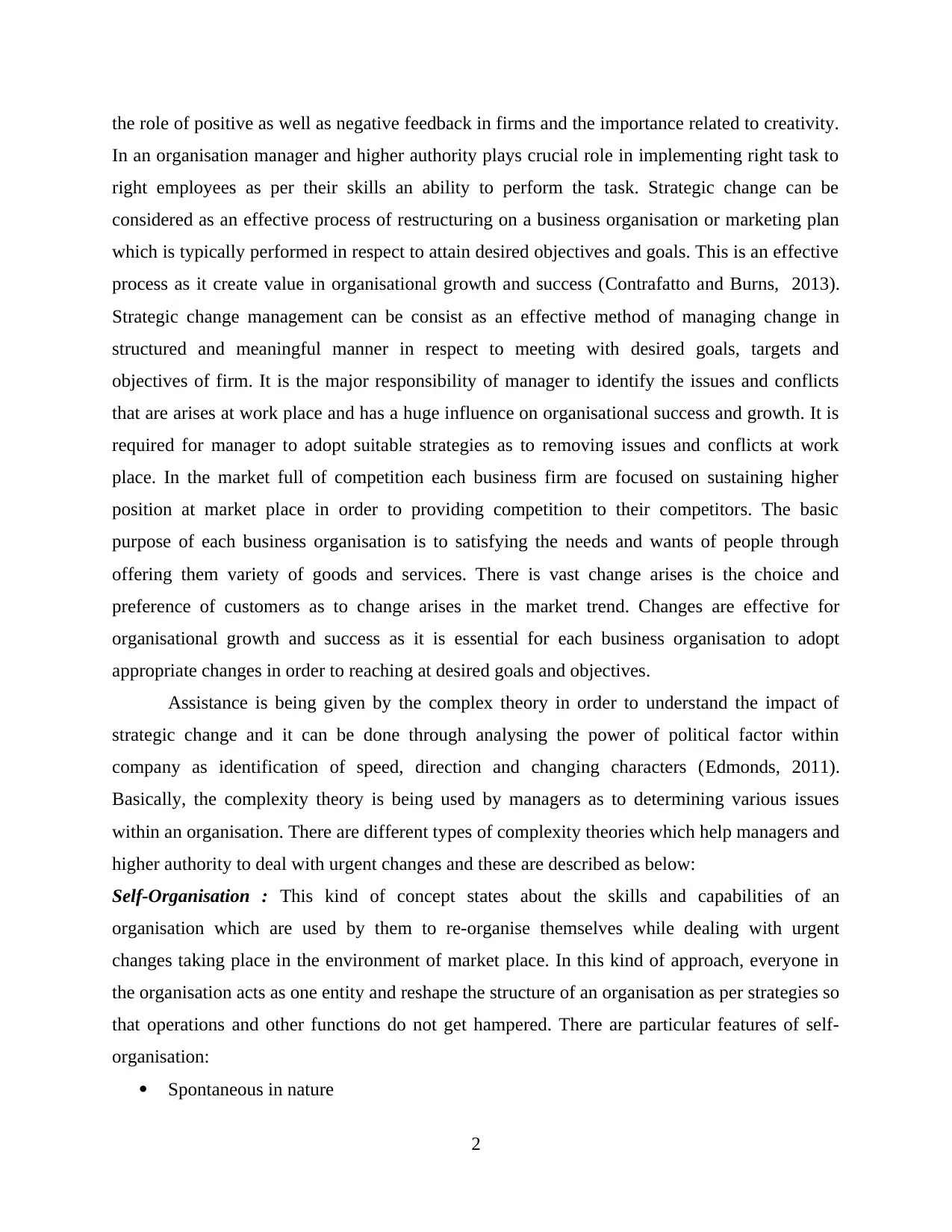
the role of positive as well as negative feedback in firms and the importance related to creativity.
In an organisation manager and higher authority plays crucial role in implementing right task to
right employees as per their skills an ability to perform the task. Strategic change can be
considered as an effective process of restructuring on a business organisation or marketing plan
which is typically performed in respect to attain desired objectives and goals. This is an effective
process as it create value in organisational growth and success (Contrafatto and Burns, 2013).
Strategic change management can be consist as an effective method of managing change in
structured and meaningful manner in respect to meeting with desired goals, targets and
objectives of firm. It is the major responsibility of manager to identify the issues and conflicts
that are arises at work place and has a huge influence on organisational success and growth. It is
required for manager to adopt suitable strategies as to removing issues and conflicts at work
place. In the market full of competition each business firm are focused on sustaining higher
position at market place in order to providing competition to their competitors. The basic
purpose of each business organisation is to satisfying the needs and wants of people through
offering them variety of goods and services. There is vast change arises is the choice and
preference of customers as to change arises in the market trend. Changes are effective for
organisational growth and success as it is essential for each business organisation to adopt
appropriate changes in order to reaching at desired goals and objectives.
Assistance is being given by the complex theory in order to understand the impact of
strategic change and it can be done through analysing the power of political factor within
company as identification of speed, direction and changing characters (Edmonds, 2011).
Basically, the complexity theory is being used by managers as to determining various issues
within an organisation. There are different types of complexity theories which help managers and
higher authority to deal with urgent changes and these are described as below:
Self-Organisation : This kind of concept states about the skills and capabilities of an
organisation which are used by them to re-organise themselves while dealing with urgent
changes taking place in the environment of market place. In this kind of approach, everyone in
the organisation acts as one entity and reshape the structure of an organisation as per strategies so
that operations and other functions do not get hampered. There are particular features of self-
organisation:
Spontaneous in nature
2
In an organisation manager and higher authority plays crucial role in implementing right task to
right employees as per their skills an ability to perform the task. Strategic change can be
considered as an effective process of restructuring on a business organisation or marketing plan
which is typically performed in respect to attain desired objectives and goals. This is an effective
process as it create value in organisational growth and success (Contrafatto and Burns, 2013).
Strategic change management can be consist as an effective method of managing change in
structured and meaningful manner in respect to meeting with desired goals, targets and
objectives of firm. It is the major responsibility of manager to identify the issues and conflicts
that are arises at work place and has a huge influence on organisational success and growth. It is
required for manager to adopt suitable strategies as to removing issues and conflicts at work
place. In the market full of competition each business firm are focused on sustaining higher
position at market place in order to providing competition to their competitors. The basic
purpose of each business organisation is to satisfying the needs and wants of people through
offering them variety of goods and services. There is vast change arises is the choice and
preference of customers as to change arises in the market trend. Changes are effective for
organisational growth and success as it is essential for each business organisation to adopt
appropriate changes in order to reaching at desired goals and objectives.
Assistance is being given by the complex theory in order to understand the impact of
strategic change and it can be done through analysing the power of political factor within
company as identification of speed, direction and changing characters (Edmonds, 2011).
Basically, the complexity theory is being used by managers as to determining various issues
within an organisation. There are different types of complexity theories which help managers and
higher authority to deal with urgent changes and these are described as below:
Self-Organisation : This kind of concept states about the skills and capabilities of an
organisation which are used by them to re-organise themselves while dealing with urgent
changes taking place in the environment of market place. In this kind of approach, everyone in
the organisation acts as one entity and reshape the structure of an organisation as per strategies so
that operations and other functions do not get hampered. There are particular features of self-
organisation:
Spontaneous in nature
2
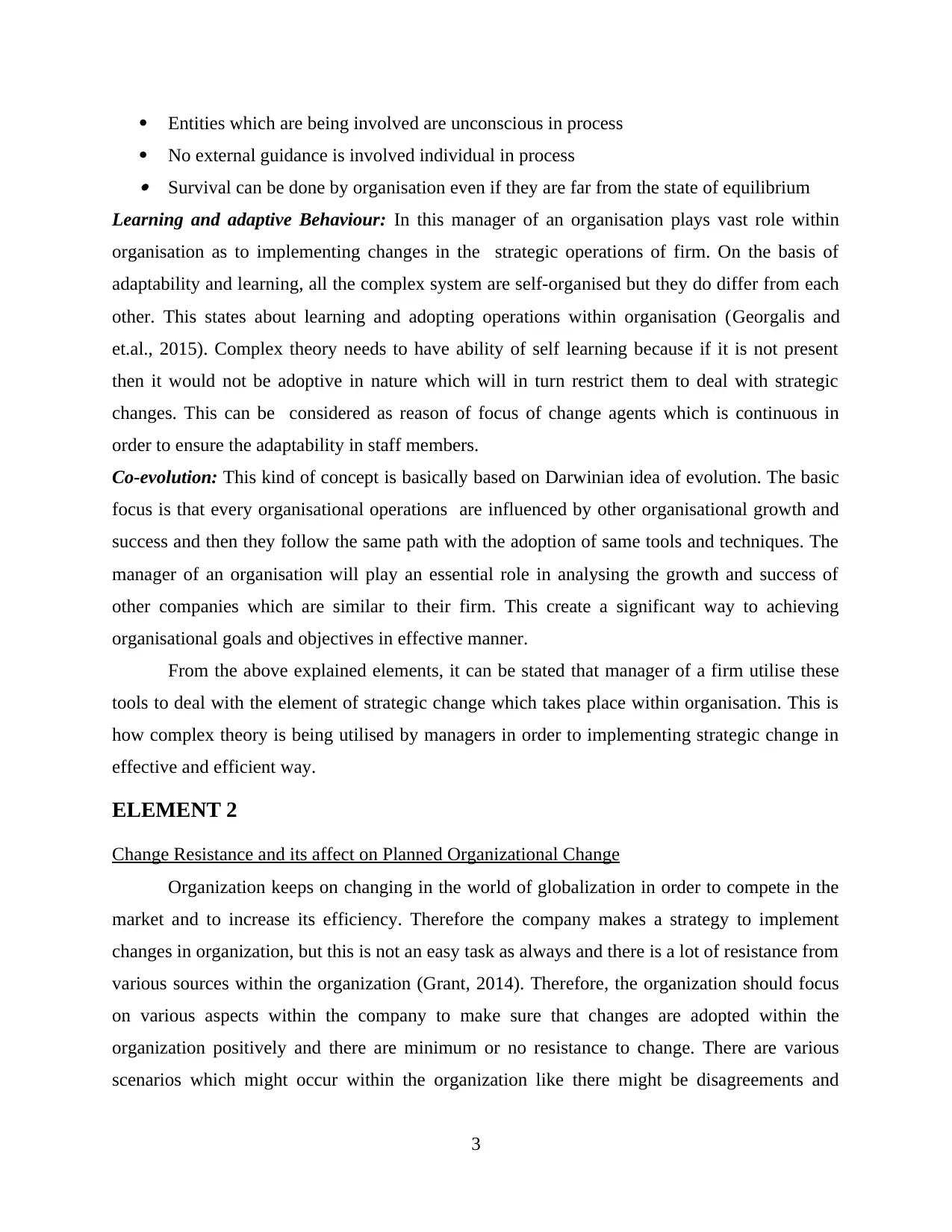
Entities which are being involved are unconscious in process
No external guidance is involved individual in process Survival can be done by organisation even if they are far from the state of equilibrium
Learning and adaptive Behaviour: In this manager of an organisation plays vast role within
organisation as to implementing changes in the strategic operations of firm. On the basis of
adaptability and learning, all the complex system are self-organised but they do differ from each
other. This states about learning and adopting operations within organisation (Georgalis and
et.al., 2015). Complex theory needs to have ability of self learning because if it is not present
then it would not be adoptive in nature which will in turn restrict them to deal with strategic
changes. This can be considered as reason of focus of change agents which is continuous in
order to ensure the adaptability in staff members.
Co-evolution: This kind of concept is basically based on Darwinian idea of evolution. The basic
focus is that every organisational operations are influenced by other organisational growth and
success and then they follow the same path with the adoption of same tools and techniques. The
manager of an organisation will play an essential role in analysing the growth and success of
other companies which are similar to their firm. This create a significant way to achieving
organisational goals and objectives in effective manner.
From the above explained elements, it can be stated that manager of a firm utilise these
tools to deal with the element of strategic change which takes place within organisation. This is
how complex theory is being utilised by managers in order to implementing strategic change in
effective and efficient way.
ELEMENT 2
Change Resistance and its affect on Planned Organizational Change
Organization keeps on changing in the world of globalization in order to compete in the
market and to increase its efficiency. Therefore the company makes a strategy to implement
changes in organization, but this is not an easy task as always and there is a lot of resistance from
various sources within the organization (Grant, 2014). Therefore, the organization should focus
on various aspects within the company to make sure that changes are adopted within the
organization positively and there are minimum or no resistance to change. There are various
scenarios which might occur within the organization like there might be disagreements and
3
No external guidance is involved individual in process Survival can be done by organisation even if they are far from the state of equilibrium
Learning and adaptive Behaviour: In this manager of an organisation plays vast role within
organisation as to implementing changes in the strategic operations of firm. On the basis of
adaptability and learning, all the complex system are self-organised but they do differ from each
other. This states about learning and adopting operations within organisation (Georgalis and
et.al., 2015). Complex theory needs to have ability of self learning because if it is not present
then it would not be adoptive in nature which will in turn restrict them to deal with strategic
changes. This can be considered as reason of focus of change agents which is continuous in
order to ensure the adaptability in staff members.
Co-evolution: This kind of concept is basically based on Darwinian idea of evolution. The basic
focus is that every organisational operations are influenced by other organisational growth and
success and then they follow the same path with the adoption of same tools and techniques. The
manager of an organisation will play an essential role in analysing the growth and success of
other companies which are similar to their firm. This create a significant way to achieving
organisational goals and objectives in effective manner.
From the above explained elements, it can be stated that manager of a firm utilise these
tools to deal with the element of strategic change which takes place within organisation. This is
how complex theory is being utilised by managers in order to implementing strategic change in
effective and efficient way.
ELEMENT 2
Change Resistance and its affect on Planned Organizational Change
Organization keeps on changing in the world of globalization in order to compete in the
market and to increase its efficiency. Therefore the company makes a strategy to implement
changes in organization, but this is not an easy task as always and there is a lot of resistance from
various sources within the organization (Grant, 2014). Therefore, the organization should focus
on various aspects within the company to make sure that changes are adopted within the
organization positively and there are minimum or no resistance to change. There are various
scenarios which might occur within the organization like there might be disagreements and
3
⊘ This is a preview!⊘
Do you want full access?
Subscribe today to unlock all pages.

Trusted by 1+ million students worldwide
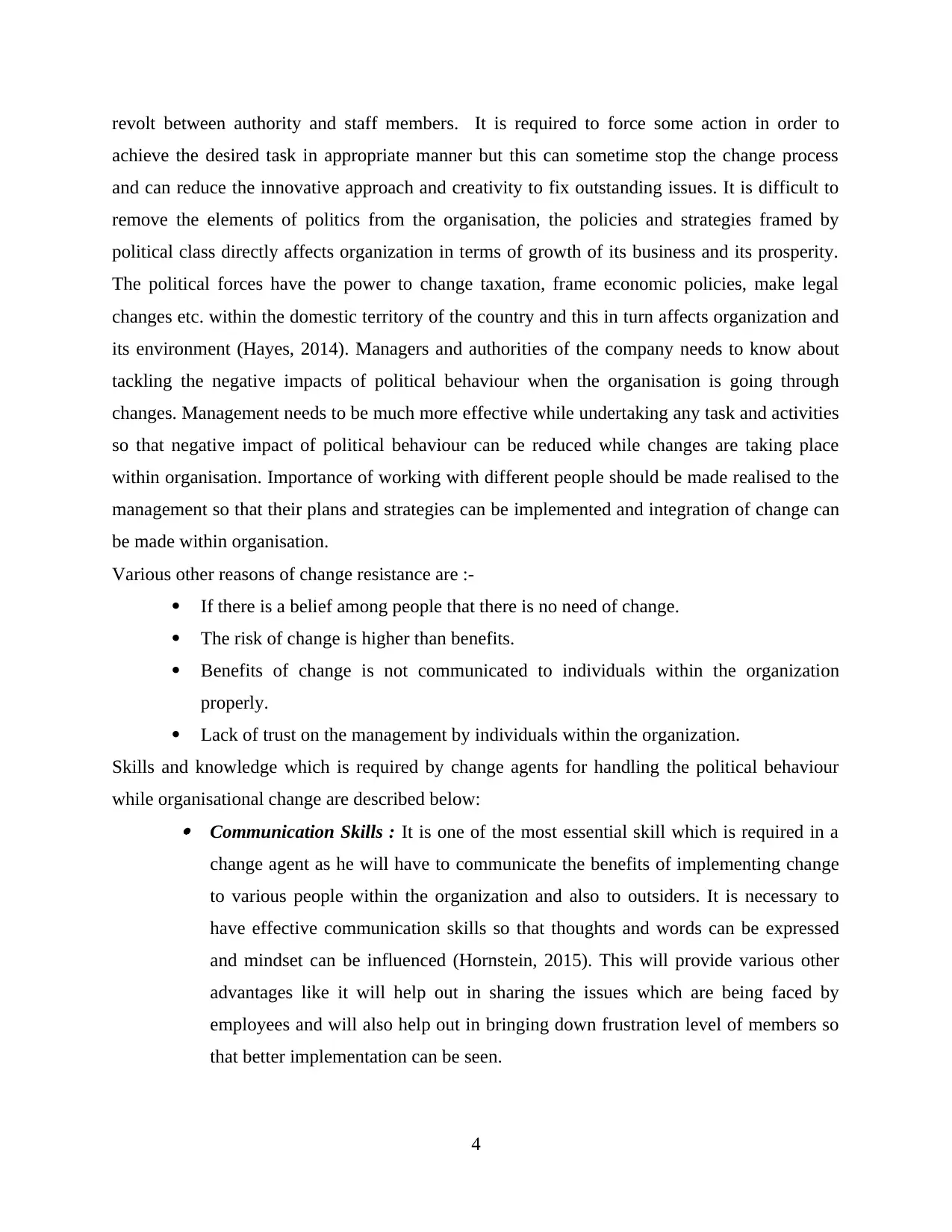
revolt between authority and staff members. It is required to force some action in order to
achieve the desired task in appropriate manner but this can sometime stop the change process
and can reduce the innovative approach and creativity to fix outstanding issues. It is difficult to
remove the elements of politics from the organisation, the policies and strategies framed by
political class directly affects organization in terms of growth of its business and its prosperity.
The political forces have the power to change taxation, frame economic policies, make legal
changes etc. within the domestic territory of the country and this in turn affects organization and
its environment (Hayes, 2014). Managers and authorities of the company needs to know about
tackling the negative impacts of political behaviour when the organisation is going through
changes. Management needs to be much more effective while undertaking any task and activities
so that negative impact of political behaviour can be reduced while changes are taking place
within organisation. Importance of working with different people should be made realised to the
management so that their plans and strategies can be implemented and integration of change can
be made within organisation.
Various other reasons of change resistance are :-
If there is a belief among people that there is no need of change.
The risk of change is higher than benefits.
Benefits of change is not communicated to individuals within the organization
properly.
Lack of trust on the management by individuals within the organization.
Skills and knowledge which is required by change agents for handling the political behaviour
while organisational change are described below:
Communication Skills : It is one of the most essential skill which is required in a
change agent as he will have to communicate the benefits of implementing change
to various people within the organization and also to outsiders. It is necessary to
have effective communication skills so that thoughts and words can be expressed
and mindset can be influenced (Hornstein, 2015). This will provide various other
advantages like it will help out in sharing the issues which are being faced by
employees and will also help out in bringing down frustration level of members so
that better implementation can be seen.
4
achieve the desired task in appropriate manner but this can sometime stop the change process
and can reduce the innovative approach and creativity to fix outstanding issues. It is difficult to
remove the elements of politics from the organisation, the policies and strategies framed by
political class directly affects organization in terms of growth of its business and its prosperity.
The political forces have the power to change taxation, frame economic policies, make legal
changes etc. within the domestic territory of the country and this in turn affects organization and
its environment (Hayes, 2014). Managers and authorities of the company needs to know about
tackling the negative impacts of political behaviour when the organisation is going through
changes. Management needs to be much more effective while undertaking any task and activities
so that negative impact of political behaviour can be reduced while changes are taking place
within organisation. Importance of working with different people should be made realised to the
management so that their plans and strategies can be implemented and integration of change can
be made within organisation.
Various other reasons of change resistance are :-
If there is a belief among people that there is no need of change.
The risk of change is higher than benefits.
Benefits of change is not communicated to individuals within the organization
properly.
Lack of trust on the management by individuals within the organization.
Skills and knowledge which is required by change agents for handling the political behaviour
while organisational change are described below:
Communication Skills : It is one of the most essential skill which is required in a
change agent as he will have to communicate the benefits of implementing change
to various people within the organization and also to outsiders. It is necessary to
have effective communication skills so that thoughts and words can be expressed
and mindset can be influenced (Hornstein, 2015). This will provide various other
advantages like it will help out in sharing the issues which are being faced by
employees and will also help out in bringing down frustration level of members so
that better implementation can be seen.
4
Paraphrase This Document
Need a fresh take? Get an instant paraphrase of this document with our AI Paraphraser
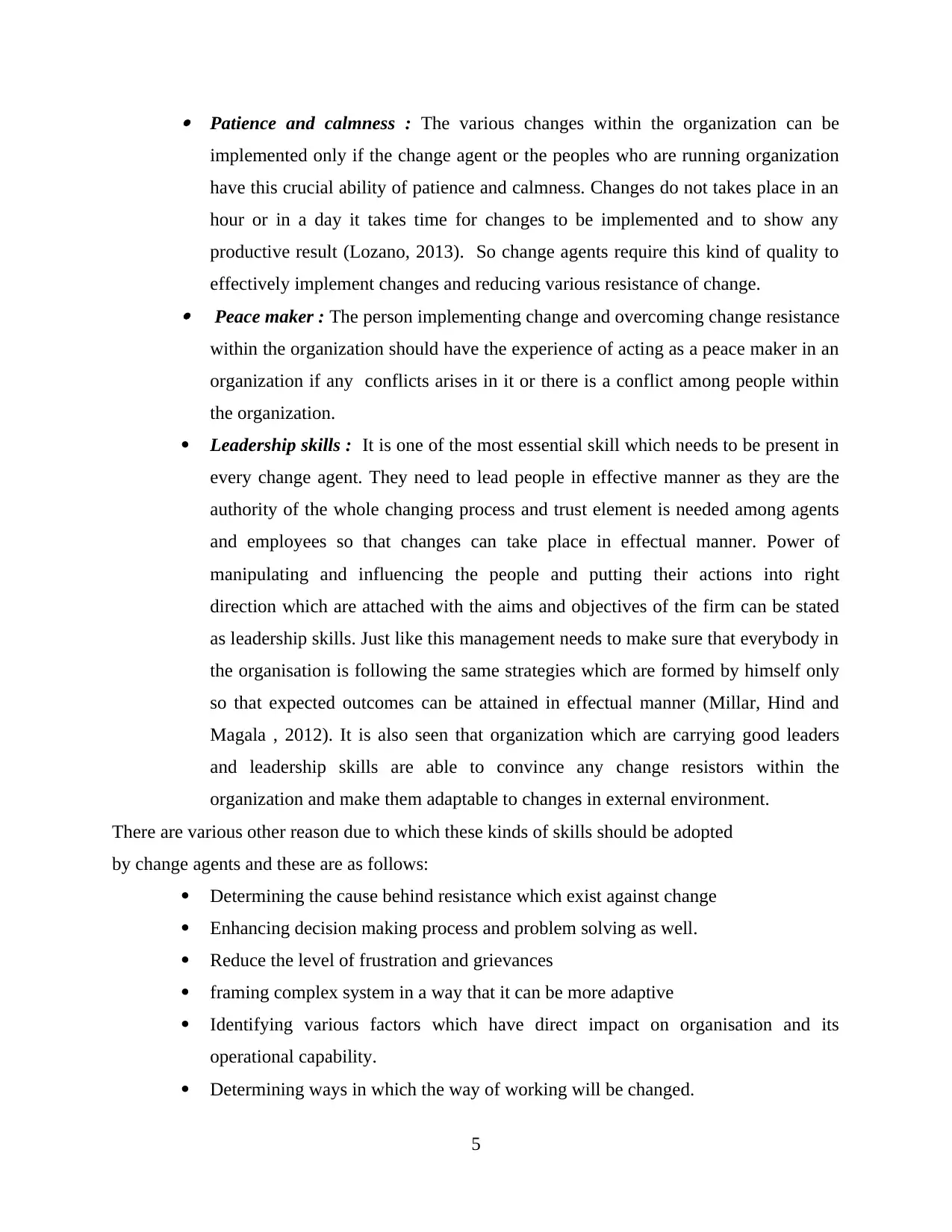
Patience and calmness : The various changes within the organization can be
implemented only if the change agent or the peoples who are running organization
have this crucial ability of patience and calmness. Changes do not takes place in an
hour or in a day it takes time for changes to be implemented and to show any
productive result (Lozano, 2013). So change agents require this kind of quality to
effectively implement changes and reducing various resistance of change.
Peace maker : The person implementing change and overcoming change resistance
within the organization should have the experience of acting as a peace maker in an
organization if any conflicts arises in it or there is a conflict among people within
the organization.
Leadership skills : It is one of the most essential skill which needs to be present in
every change agent. They need to lead people in effective manner as they are the
authority of the whole changing process and trust element is needed among agents
and employees so that changes can take place in effectual manner. Power of
manipulating and influencing the people and putting their actions into right
direction which are attached with the aims and objectives of the firm can be stated
as leadership skills. Just like this management needs to make sure that everybody in
the organisation is following the same strategies which are formed by himself only
so that expected outcomes can be attained in effectual manner (Millar, Hind and
Magala , 2012). It is also seen that organization which are carrying good leaders
and leadership skills are able to convince any change resistors within the
organization and make them adaptable to changes in external environment.
There are various other reason due to which these kinds of skills should be adopted
by change agents and these are as follows:
Determining the cause behind resistance which exist against change
Enhancing decision making process and problem solving as well.
Reduce the level of frustration and grievances
framing complex system in a way that it can be more adaptive
Identifying various factors which have direct impact on organisation and its
operational capability.
Determining ways in which the way of working will be changed.
5
implemented only if the change agent or the peoples who are running organization
have this crucial ability of patience and calmness. Changes do not takes place in an
hour or in a day it takes time for changes to be implemented and to show any
productive result (Lozano, 2013). So change agents require this kind of quality to
effectively implement changes and reducing various resistance of change.
Peace maker : The person implementing change and overcoming change resistance
within the organization should have the experience of acting as a peace maker in an
organization if any conflicts arises in it or there is a conflict among people within
the organization.
Leadership skills : It is one of the most essential skill which needs to be present in
every change agent. They need to lead people in effective manner as they are the
authority of the whole changing process and trust element is needed among agents
and employees so that changes can take place in effectual manner. Power of
manipulating and influencing the people and putting their actions into right
direction which are attached with the aims and objectives of the firm can be stated
as leadership skills. Just like this management needs to make sure that everybody in
the organisation is following the same strategies which are formed by himself only
so that expected outcomes can be attained in effectual manner (Millar, Hind and
Magala , 2012). It is also seen that organization which are carrying good leaders
and leadership skills are able to convince any change resistors within the
organization and make them adaptable to changes in external environment.
There are various other reason due to which these kinds of skills should be adopted
by change agents and these are as follows:
Determining the cause behind resistance which exist against change
Enhancing decision making process and problem solving as well.
Reduce the level of frustration and grievances
framing complex system in a way that it can be more adaptive
Identifying various factors which have direct impact on organisation and its
operational capability.
Determining ways in which the way of working will be changed.
5
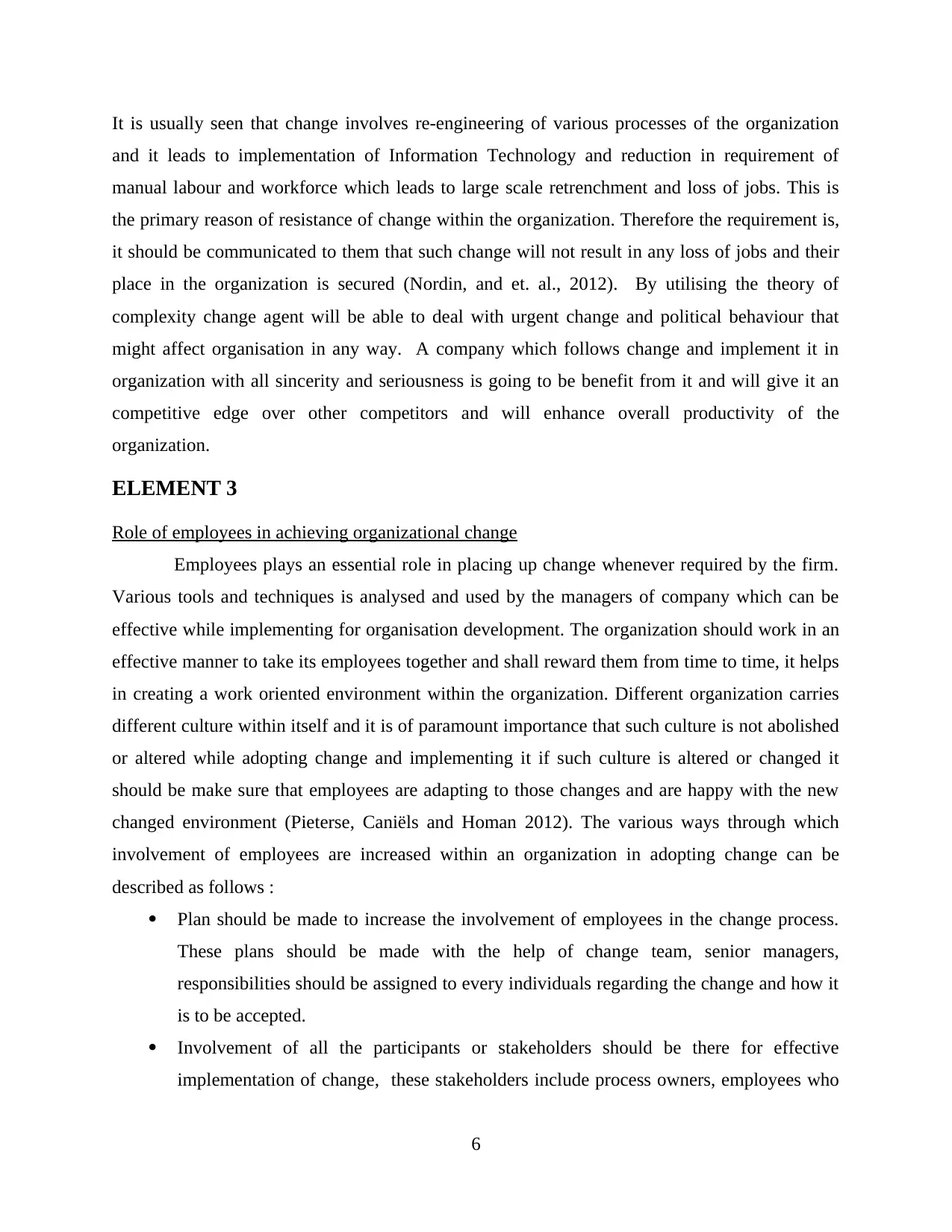
It is usually seen that change involves re-engineering of various processes of the organization
and it leads to implementation of Information Technology and reduction in requirement of
manual labour and workforce which leads to large scale retrenchment and loss of jobs. This is
the primary reason of resistance of change within the organization. Therefore the requirement is,
it should be communicated to them that such change will not result in any loss of jobs and their
place in the organization is secured (Nordin, and et. al., 2012). By utilising the theory of
complexity change agent will be able to deal with urgent change and political behaviour that
might affect organisation in any way. A company which follows change and implement it in
organization with all sincerity and seriousness is going to be benefit from it and will give it an
competitive edge over other competitors and will enhance overall productivity of the
organization.
ELEMENT 3
Role of employees in achieving organizational change
Employees plays an essential role in placing up change whenever required by the firm.
Various tools and techniques is analysed and used by the managers of company which can be
effective while implementing for organisation development. The organization should work in an
effective manner to take its employees together and shall reward them from time to time, it helps
in creating a work oriented environment within the organization. Different organization carries
different culture within itself and it is of paramount importance that such culture is not abolished
or altered while adopting change and implementing it if such culture is altered or changed it
should be make sure that employees are adapting to those changes and are happy with the new
changed environment (Pieterse, Caniëls and Homan 2012). The various ways through which
involvement of employees are increased within an organization in adopting change can be
described as follows :
Plan should be made to increase the involvement of employees in the change process.
These plans should be made with the help of change team, senior managers,
responsibilities should be assigned to every individuals regarding the change and how it
is to be accepted.
Involvement of all the participants or stakeholders should be there for effective
implementation of change, these stakeholders include process owners, employees who
6
and it leads to implementation of Information Technology and reduction in requirement of
manual labour and workforce which leads to large scale retrenchment and loss of jobs. This is
the primary reason of resistance of change within the organization. Therefore the requirement is,
it should be communicated to them that such change will not result in any loss of jobs and their
place in the organization is secured (Nordin, and et. al., 2012). By utilising the theory of
complexity change agent will be able to deal with urgent change and political behaviour that
might affect organisation in any way. A company which follows change and implement it in
organization with all sincerity and seriousness is going to be benefit from it and will give it an
competitive edge over other competitors and will enhance overall productivity of the
organization.
ELEMENT 3
Role of employees in achieving organizational change
Employees plays an essential role in placing up change whenever required by the firm.
Various tools and techniques is analysed and used by the managers of company which can be
effective while implementing for organisation development. The organization should work in an
effective manner to take its employees together and shall reward them from time to time, it helps
in creating a work oriented environment within the organization. Different organization carries
different culture within itself and it is of paramount importance that such culture is not abolished
or altered while adopting change and implementing it if such culture is altered or changed it
should be make sure that employees are adapting to those changes and are happy with the new
changed environment (Pieterse, Caniëls and Homan 2012). The various ways through which
involvement of employees are increased within an organization in adopting change can be
described as follows :
Plan should be made to increase the involvement of employees in the change process.
These plans should be made with the help of change team, senior managers,
responsibilities should be assigned to every individuals regarding the change and how it
is to be accepted.
Involvement of all the participants or stakeholders should be there for effective
implementation of change, these stakeholders include process owners, employees who
6
⊘ This is a preview!⊘
Do you want full access?
Subscribe today to unlock all pages.

Trusted by 1+ million students worldwide
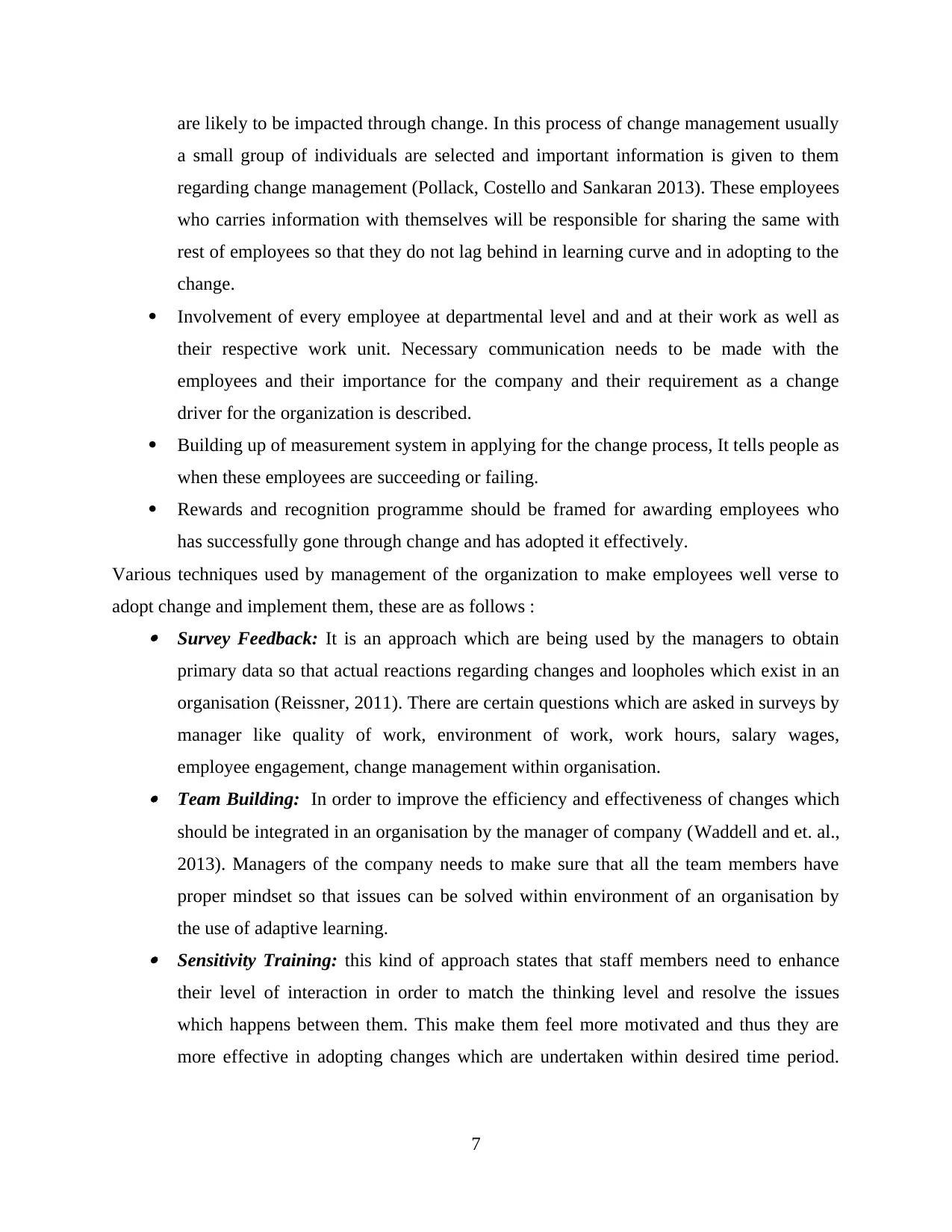
are likely to be impacted through change. In this process of change management usually
a small group of individuals are selected and important information is given to them
regarding change management (Pollack, Costello and Sankaran 2013). These employees
who carries information with themselves will be responsible for sharing the same with
rest of employees so that they do not lag behind in learning curve and in adopting to the
change.
Involvement of every employee at departmental level and and at their work as well as
their respective work unit. Necessary communication needs to be made with the
employees and their importance for the company and their requirement as a change
driver for the organization is described.
Building up of measurement system in applying for the change process, It tells people as
when these employees are succeeding or failing.
Rewards and recognition programme should be framed for awarding employees who
has successfully gone through change and has adopted it effectively.
Various techniques used by management of the organization to make employees well verse to
adopt change and implement them, these are as follows : Survey Feedback: It is an approach which are being used by the managers to obtain
primary data so that actual reactions regarding changes and loopholes which exist in an
organisation (Reissner, 2011). There are certain questions which are asked in surveys by
manager like quality of work, environment of work, work hours, salary wages,
employee engagement, change management within organisation. Team Building: In order to improve the efficiency and effectiveness of changes which
should be integrated in an organisation by the manager of company (Waddell and et. al.,
2013). Managers of the company needs to make sure that all the team members have
proper mindset so that issues can be solved within environment of an organisation by
the use of adaptive learning. Sensitivity Training: this kind of approach states that staff members need to enhance
their level of interaction in order to match the thinking level and resolve the issues
which happens between them. This make them feel more motivated and thus they are
more effective in adopting changes which are undertaken within desired time period.
7
a small group of individuals are selected and important information is given to them
regarding change management (Pollack, Costello and Sankaran 2013). These employees
who carries information with themselves will be responsible for sharing the same with
rest of employees so that they do not lag behind in learning curve and in adopting to the
change.
Involvement of every employee at departmental level and and at their work as well as
their respective work unit. Necessary communication needs to be made with the
employees and their importance for the company and their requirement as a change
driver for the organization is described.
Building up of measurement system in applying for the change process, It tells people as
when these employees are succeeding or failing.
Rewards and recognition programme should be framed for awarding employees who
has successfully gone through change and has adopted it effectively.
Various techniques used by management of the organization to make employees well verse to
adopt change and implement them, these are as follows : Survey Feedback: It is an approach which are being used by the managers to obtain
primary data so that actual reactions regarding changes and loopholes which exist in an
organisation (Reissner, 2011). There are certain questions which are asked in surveys by
manager like quality of work, environment of work, work hours, salary wages,
employee engagement, change management within organisation. Team Building: In order to improve the efficiency and effectiveness of changes which
should be integrated in an organisation by the manager of company (Waddell and et. al.,
2013). Managers of the company needs to make sure that all the team members have
proper mindset so that issues can be solved within environment of an organisation by
the use of adaptive learning. Sensitivity Training: this kind of approach states that staff members need to enhance
their level of interaction in order to match the thinking level and resolve the issues
which happens between them. This make them feel more motivated and thus they are
more effective in adopting changes which are undertaken within desired time period.
7
Paraphrase This Document
Need a fresh take? Get an instant paraphrase of this document with our AI Paraphraser
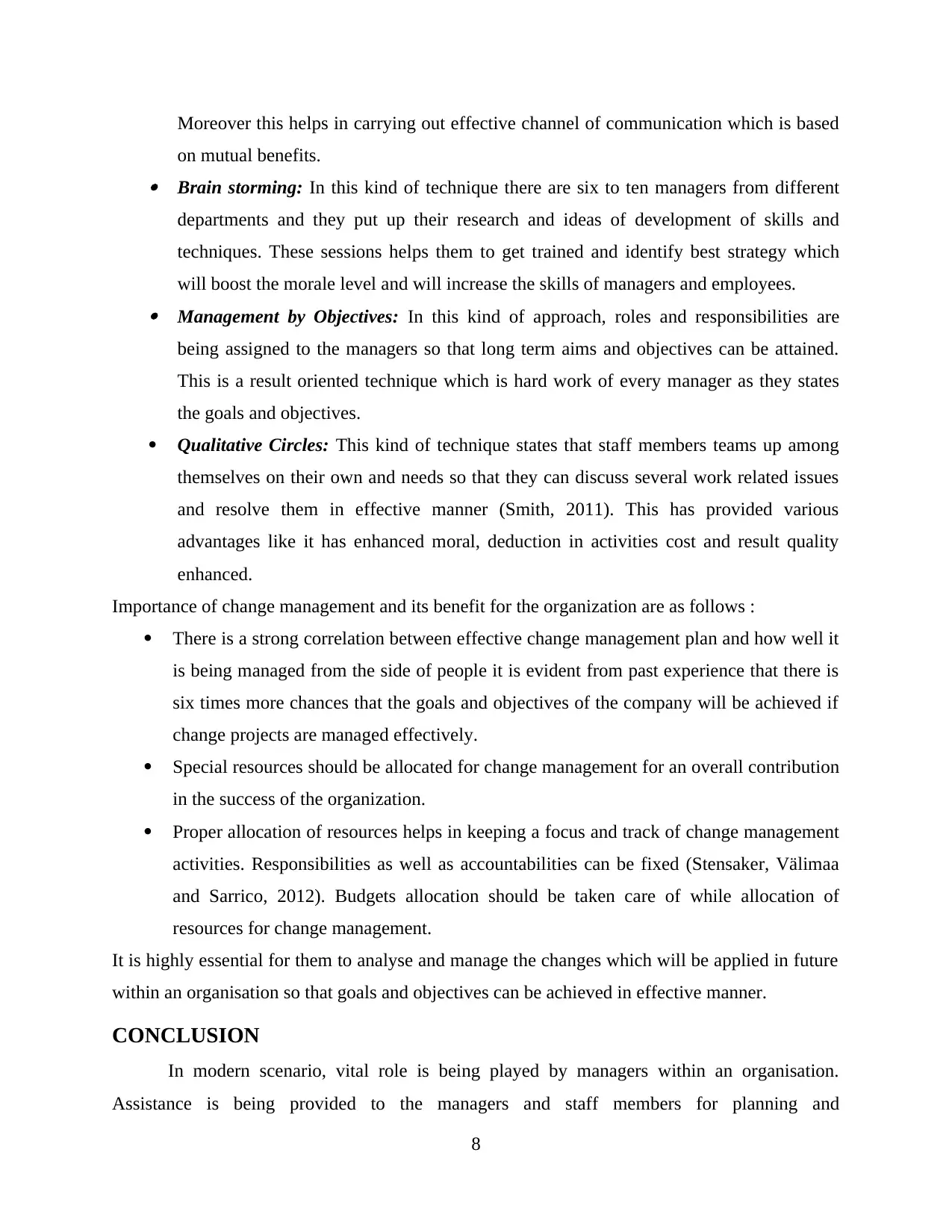
Moreover this helps in carrying out effective channel of communication which is based
on mutual benefits. Brain storming: In this kind of technique there are six to ten managers from different
departments and they put up their research and ideas of development of skills and
techniques. These sessions helps them to get trained and identify best strategy which
will boost the morale level and will increase the skills of managers and employees. Management by Objectives: In this kind of approach, roles and responsibilities are
being assigned to the managers so that long term aims and objectives can be attained.
This is a result oriented technique which is hard work of every manager as they states
the goals and objectives.
Qualitative Circles: This kind of technique states that staff members teams up among
themselves on their own and needs so that they can discuss several work related issues
and resolve them in effective manner (Smith, 2011). This has provided various
advantages like it has enhanced moral, deduction in activities cost and result quality
enhanced.
Importance of change management and its benefit for the organization are as follows :
There is a strong correlation between effective change management plan and how well it
is being managed from the side of people it is evident from past experience that there is
six times more chances that the goals and objectives of the company will be achieved if
change projects are managed effectively.
Special resources should be allocated for change management for an overall contribution
in the success of the organization.
Proper allocation of resources helps in keeping a focus and track of change management
activities. Responsibilities as well as accountabilities can be fixed (Stensaker, Välimaa
and Sarrico, 2012). Budgets allocation should be taken care of while allocation of
resources for change management.
It is highly essential for them to analyse and manage the changes which will be applied in future
within an organisation so that goals and objectives can be achieved in effective manner.
CONCLUSION
In modern scenario, vital role is being played by managers within an organisation.
Assistance is being provided to the managers and staff members for planning and
8
on mutual benefits. Brain storming: In this kind of technique there are six to ten managers from different
departments and they put up their research and ideas of development of skills and
techniques. These sessions helps them to get trained and identify best strategy which
will boost the morale level and will increase the skills of managers and employees. Management by Objectives: In this kind of approach, roles and responsibilities are
being assigned to the managers so that long term aims and objectives can be attained.
This is a result oriented technique which is hard work of every manager as they states
the goals and objectives.
Qualitative Circles: This kind of technique states that staff members teams up among
themselves on their own and needs so that they can discuss several work related issues
and resolve them in effective manner (Smith, 2011). This has provided various
advantages like it has enhanced moral, deduction in activities cost and result quality
enhanced.
Importance of change management and its benefit for the organization are as follows :
There is a strong correlation between effective change management plan and how well it
is being managed from the side of people it is evident from past experience that there is
six times more chances that the goals and objectives of the company will be achieved if
change projects are managed effectively.
Special resources should be allocated for change management for an overall contribution
in the success of the organization.
Proper allocation of resources helps in keeping a focus and track of change management
activities. Responsibilities as well as accountabilities can be fixed (Stensaker, Välimaa
and Sarrico, 2012). Budgets allocation should be taken care of while allocation of
resources for change management.
It is highly essential for them to analyse and manage the changes which will be applied in future
within an organisation so that goals and objectives can be achieved in effective manner.
CONCLUSION
In modern scenario, vital role is being played by managers within an organisation.
Assistance is being provided to the managers and staff members for planning and
8
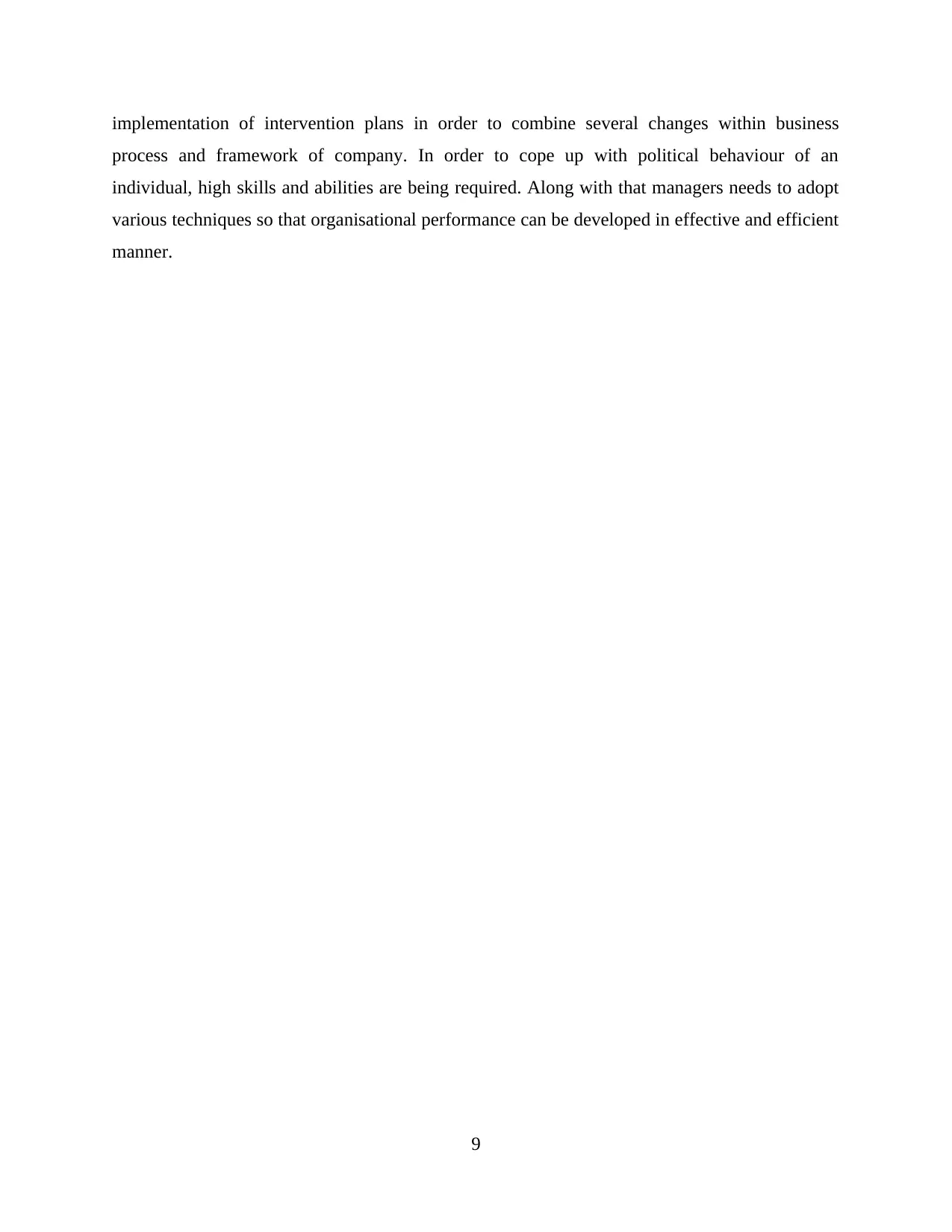
implementation of intervention plans in order to combine several changes within business
process and framework of company. In order to cope up with political behaviour of an
individual, high skills and abilities are being required. Along with that managers needs to adopt
various techniques so that organisational performance can be developed in effective and efficient
manner.
9
process and framework of company. In order to cope up with political behaviour of an
individual, high skills and abilities are being required. Along with that managers needs to adopt
various techniques so that organisational performance can be developed in effective and efficient
manner.
9
⊘ This is a preview!⊘
Do you want full access?
Subscribe today to unlock all pages.

Trusted by 1+ million students worldwide
1 out of 14
Related Documents
Your All-in-One AI-Powered Toolkit for Academic Success.
+13062052269
info@desklib.com
Available 24*7 on WhatsApp / Email
![[object Object]](/_next/static/media/star-bottom.7253800d.svg)
Unlock your academic potential
Copyright © 2020–2025 A2Z Services. All Rights Reserved. Developed and managed by ZUCOL.





